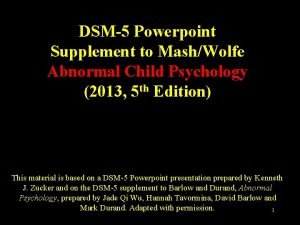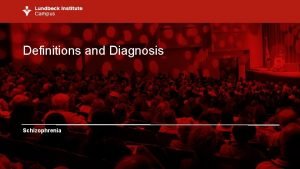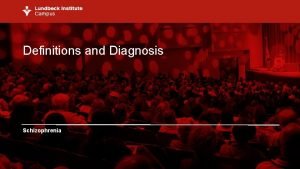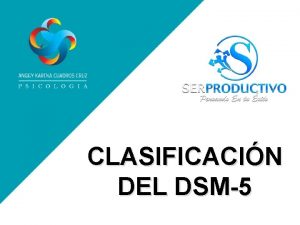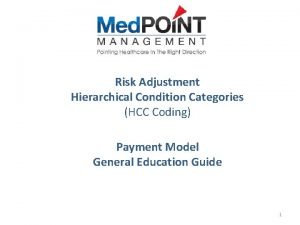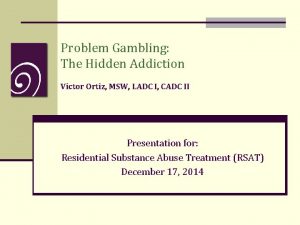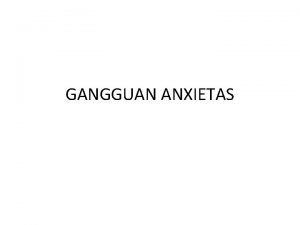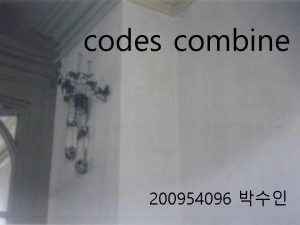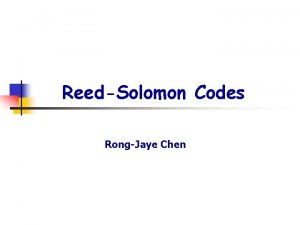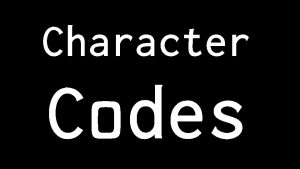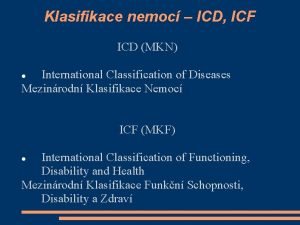ICD Z Codes WHO and the DSM 5









- Slides: 9

ICD (Z Codes), WHO, and the DSM 5

Definition of a Mental Disorder • “…A mental disorder is a syndrome characterized by clinically significant disturbance in an individual’s cognition, emotion, regulation, or behavior that reflects a dysfunction in the psychological, biological, or developmental processes underlying mental functioning. • Mental disorders are usually associated with significant distress or disability in social, occupational, or other important activities…” DSM-5

Mental Disorder and Disability: How to Distinguish the Two • Disability: impairment in social, occupational, or other important area of functioning. • International Classification of Diseases (ICD) • • All diseases and disorders International Classification of Functioning, Disability, and Health (ICF) • Classification of global disability

• WHO’s Disability Assessment Schedule (WHODAS) • • Used as standardized measure of disability for mental disorders. Concern: “In absence of clear biological markers or clinically useful measurements of severity for mental disorders, not possible to completely separate normal and pathological symptom expressions contained in the diagnostic criteria” - DSM 5

Elements of a Diagnosis • Diagnostic criteria are offered as guidelines for making diagnoses and should be informed by clinical judgement. • Disorder subtypes and/or specifiers • Should be applied to denote the individual’s current presentation *only when full criteria are met. * • Not fully met? —> “other specified” or “unspecified” diagnosis.

Subtypes and Specifiers • Subtypes: define mutually exclusive and jointly exhaustive phenomenological subgrouping within a diagnosis. —> “Specify whether” • Specifiers: not mutually exclusive or jointly exhaustive —> more than one specifier may be given. —> Indicated by “Specify” or “Specify if”

• 5 th digit in codes: sometimes assigned to code a subtype/specifier or severity: • Ex. of subtype/specifier: 294. 11 [F 02. 81] • • Ex. of severity 296. 21 [F 32. 0] • • Major neurocognitive disorder due to Alzheimer’s diseasse, with behavioral disturbance) Major depressive disorder, single episode, mild Majority of subtypes and specifiers included in DSM-V cannot be coded within the ICD-9 -CM (V Codes) and ICD-10 -CM (Z Codes) systems • Social Anxiety disorder [social phobia], performance type

Coding and Reporting Procedures • Each disorder is accompanied by an identifying diagnostic and statistical code • Institutions and agencies for data collection and billing purposes • Identified as “coding notes” in text • Established by WHO, US centers for medicare and medicaid services (CMS), and Centers for Disease control and Prevention’s national center for health statistics to ensure consistent international recording of prevalence and mortality rates for ID’d health conditions • Most clinicians use codes to identify the diagnosis or reason for visit for CMS and private insurance service claims. • Adoption of ICD-10 -CM codes (aka Z codes) took place in Oct. 2014. Both ICD-9 CM codes (V codes) and the ICD-10 -CM codes (Z codes) are listed in the back of the DSM-5.

